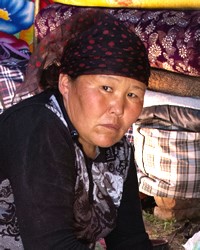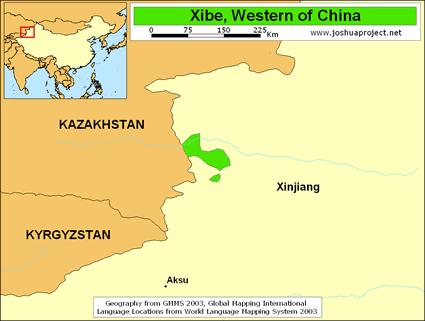There are major cultural and linguistic differences between Western Xibe and the Xibe in northeastern China. The Western Xibe have "preserved their own speech, clothing, and housing much better."
More than two centuries of separation from the Xibe in Liaoning has resulted in "a fair number of words" that are different. Many Western Xibe are bilingual or multilingual in Chinese, Kazakh, Uygur, Russian, and Mongolian. Xibe is a written language which uses a reformed Manchu script. About half of the Xibe in Xinjiang can speak their language.
The Western Xibe are the descendants of a Manchu garrison, 3,000-strong, sent to Xinjiang in the spring of 1763 to rule the territory of the recently defeated Jungars. "The officer in charge of the migration, lining his pockets with the money earmarked for the migration, cut down the time for the journey from two years to one. Many died on the way from exhaustion and practically all the infants had to be abandoned in the wilderness as they moved on." It was a year-long trek to Xinjiang.
The Western Xibe "excel at archery and are known for their remarkable horsemanship. Their enemies know well how lethal their iron arrow-heads really are. Even Nu'erhachi, a leader of the Manchurian aristocrats, was wounded in the skull in a battle against the Xibes when an arrowhead actually pierced his iron helmet." When a Western Xibe girl is born, the family hangs a red banner at the door as an announcement to their neighbors. When a boy is born, they display an archer's bow.
The primary religion among the Western Xibe is shamanism. Others follow Tibetan Buddhism, while still others are classified as polytheists who worship the traditional Xibe deities of Xilimama and Haierkan. Despite being surrounded by Muslims, the Western Xibe have resisted all pressure to convert to Islam.
A visitor to Xinjiang recently commented, "Many Xibe have adopted the religion of their Han neighbors which means that some have even become Christians!" They are the first known believers among the Western Xibe. They are being formed into indigenous Xibe churches. Hudson Taylor once stated, "Why should a foreign aspect be given to Christianity? We wish to see churches of such believers presided over by pastors of their own countrymen, worshiping God in their own tongue, in edifices of a thoroughly native style."
People everywhere need adequate food, clothing, shelter and a sense of peace and calm. Most of all, they need a savior who can lead them into lives of peace and joy.
Pray for the Lord to send the workers and materials needed.
Pray for the workers to have hearts of love for the Xibe people.
May the Xibe people have hearts to the truths of his word.
Scripture Prayers for the Xibe, Western in China.
Operation China, Asia Harvest, Copyrighted © Used with permission.
| Profile Source: Joshua Project |











